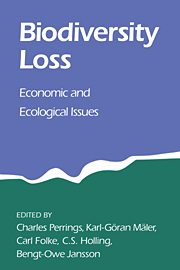Book contents
- Frontmatter
- Contents
- Foreword
- Preface
- List of contributors
- Introduction: framing the problem of biodiversity loss
- PART I CONCEPTUALISING DIVERSITY AND ECOSYSTEM FUNCTIONS
- PART II INTEGRATING ECOLOGY AND ECONOMICS IN THE ANALYSIS OF BIODIVERSITY LOSS
- 4 Wetland valuation: three case studies
- 5 An ecological economy: notes on harvest and growth
- 6 Biodiversity loss and the economics of discontinuous change in semiarid rangelands
- PART III ECONOMIC ISSUES
- PART IV CONCLUSIONS
- References
- Index
6 - Biodiversity loss and the economics of discontinuous change in semiarid rangelands
Published online by Cambridge University Press: 05 June 2012
- Frontmatter
- Contents
- Foreword
- Preface
- List of contributors
- Introduction: framing the problem of biodiversity loss
- PART I CONCEPTUALISING DIVERSITY AND ECOSYSTEM FUNCTIONS
- PART II INTEGRATING ECOLOGY AND ECONOMICS IN THE ANALYSIS OF BIODIVERSITY LOSS
- 4 Wetland valuation: three case studies
- 5 An ecological economy: notes on harvest and growth
- 6 Biodiversity loss and the economics of discontinuous change in semiarid rangelands
- PART III ECONOMIC ISSUES
- PART IV CONCLUSIONS
- References
- Index
Summary
Introduction
One of the main biological challenges to the economics of natural resource utilisation relates to the fact that almost all dynamic resource models are now being shown to ignore those properties of natural systems which most affect their evolution over time. The economic utilisation of natural resources involves the exploitation of ecological systems that turn out to be highly nonlinear, and characterised by discontinuous and sometimes irreversible change around a range of “thresholds.” Yet most resource models either implicitly or explicitly assume the continuity, differentiability and reversibility of the underlying ecological functions. It has long been recognised that negative environmental externalities compromise the concavity–convexity conditions for social optima (cf Baumol and Bradford 1972; Starrett 1972), but the problem raised by the complexity of ecological systems goes well beyond the nonconvexity of the social possibility set. Discontinuities in the evolution of economically exploited ecological systems imply discontinuities in the economic system. That is, if economic pressure on any ecosystem causes it to “crash” – to undergo some fundamental and irreversible internal reorganisation – then the economic activities concerned will be similarly disrupted. Since many of the sources of discontinuous change in economically important ecological systems lie in the alteration of species diversity, this challenge is raised in a particularly acute way in the biodiversity problem.
- Type
- Chapter
- Information
- Biodiversity LossEconomic and Ecological Issues, pp. 190 - 210Publisher: Cambridge University PressPrint publication year: 1995
- 16
- Cited by



